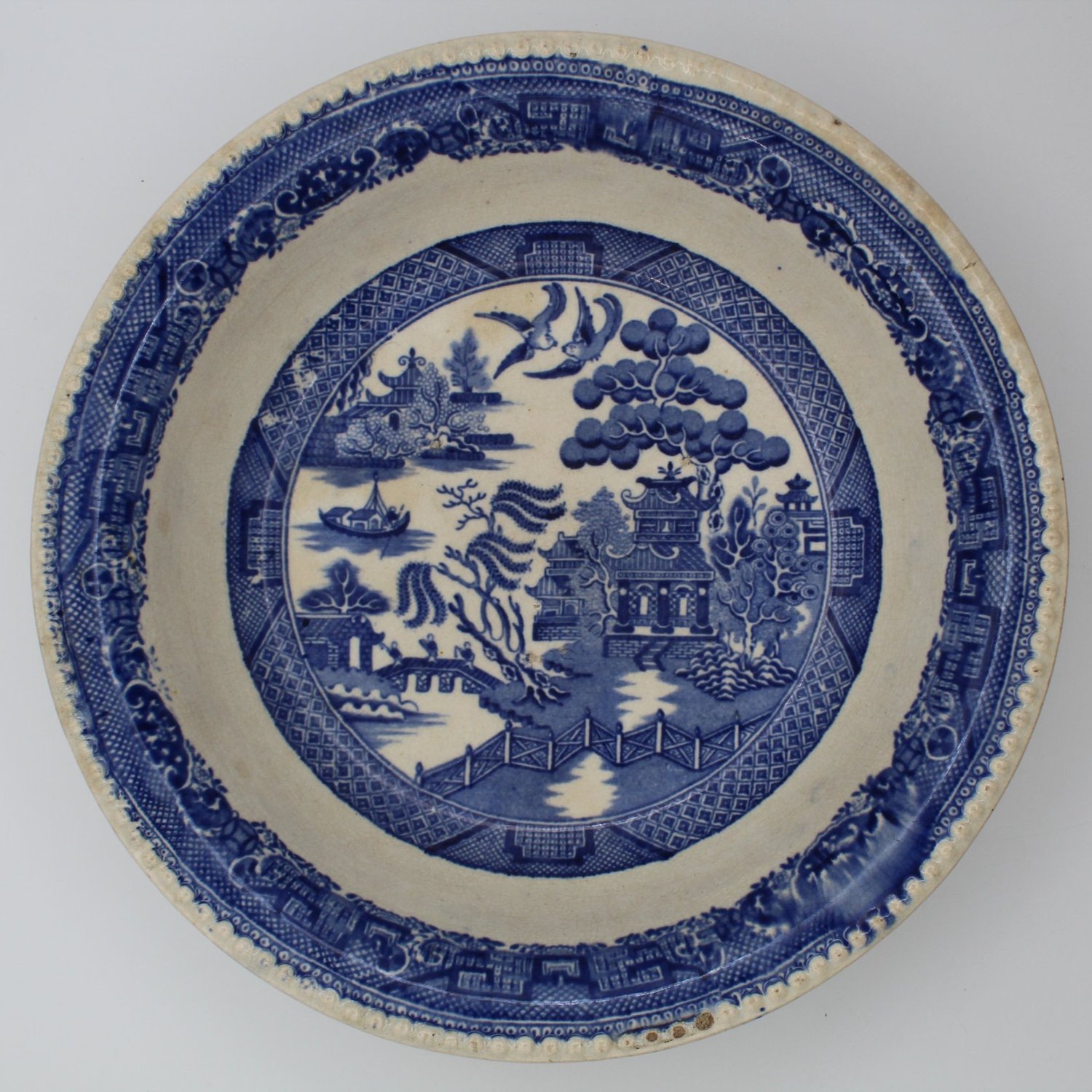
Willow
The iconic blue pattern- and a colourful variation
Since it was created, Blue Willow has been well-known, widely available, and very popular.
This pattern was created to mimic Chinese ceramics and was made in England’s Staffordshire region starting in the 1800s. It began as a popular import and became a popular collectible in the 1870s.
Various pieces of Willow dishes. Shown in further detail and identified below.
Blue Willow is an example of early mass production.
Transfer printing combined printmaking and ceramics, speeding up the decorating process.
Patterns were engraved onto metal plates, printed onto tissue paper, and then transferred to the piece of pottery. Each step had to be done carefully or the result would look messy.
Pieces decorated with transfer printing are called transferware.
Transfer printing used child labour: young girls were employed to cut the printed tissue into sections.
Detail of the Blue Willow pattern.
The two birds are the most recognizable motif.
Two luncheon plates in flow blue Blue Willow pattern (2 of 4). 23 cm diameter. Date and manufacturer unknown. 1975.909.20 (left) and 1975.909.21 (right). The plate on the right is likely misprinted. (Compare the borders. One section doesn’t quite line up).
Transfer printing results in small differences between pieces – both accidental and deliberate.
Platter with Blue Willow pattern. M. T. & Co., England, c. 1850s. 30 cm wide. 1975.909.43
Blue Willow was the most popular ceramic pattern in the 19th century Canada
At that time, most pottery was imported, and the popular imports had printed patterns. Willow was one of the oldest printed patterns and by far the most popular.
Collectors call glaze that bleeds and blurs flow blue.
It was the only pattern that was popular enough to be advertised and sold in Canada by name, not just as “printed china.” It was available on many kinds of ceramic tableware.
Coaster with Blue Willow pattern. Company unknown, England, 19th-early 20th century. 10 cm diameter. 1975.909.36
Printing and cutting allowed makers to customize the pattern.
Mustard pot with Blue Willow pattern. Company unknown, England, circa 1880s. 7 cm tall. 1975.909.32
This mustard pot is decorated with multiple small sections that were cut out from the Willow pattern. The swallows that typically fly high above the willow tree have been repositioned right beside it to fit on this squat piece.
Gravy/sauce boat with Blue Willow pattern. Company unknown, England c. 1880s. 11 cm tall. 1975.909.29
Imported printed ceramics of varying quality were widely available. They were generally meant to be used, not collected. The damage on this piece shows that it was very well-used.

Blue Willow became collectible in the 1870s, when American “chinamania” began.
Americans reinterpreted old pottery. They looked back upon Old Blue Staffordshire (c. 1815-1840) as a representation of the heroic days of pioneer America, a form of art, and a manifestation of good taste—not merely old dishes meant for daily use.
China collecting became a popular pastime, and this trend helped Blue Willow become the collectible it is now. The pattern is common enough for antique collectors to easily recognize and acquire at reasonable prices.
Platter with light Blue Willow pattern. Podmore, Walker & Co., England, 1834-1856. 36 cm wide. 1975.909.41
Elite Victorian china collectors probably wouldn’t like this piece.
They preferred darker blue wares, which were popular from about 1820-1830, over lighter blue pieces like this, which were made after 1830.
Candy dish with Blue Willow pattern (1 of 2). Company unknown, England, circa 1880s.
17 cm wide. 1975.909.34
Western ceramics have mimicked East Asian ceramics for centuries.
Many ceramics patterns—including every pattern in Jean’s collection— copy, mimic, or draw from Chinese or Japanese art.
In Canada, the Blue Willow pattern remained popular amidst rising Sinophobia (fear or hatred of Chinese people and culture), the passing of the anti-Chinese head tax in 1885, and a sweeping anti-Chinese immigration ban that was in place from 1923 to 1947.
Lidded vegetable dish with Blue Willow pattern. Company unknown, England, c. 1850s. 19 cm tall. 1975.909.39
The Willow pattern follows common themes in Jean Shields’ curated collection
Jean used similar patterns, for different effects. She was drawn to East Asian-inspired patterns, intricate designs with floral motifs, and shades of reddish-orange and cobalt blue.
Dinner plate with Coloured/Gaudy Willow pattern. Company unknown, England, c. 1800s. 27 cm diameter. 1994.1.41
This is an uncommon variant of Coloured/Gaudy Willow: the pattern typically features two birds and has larger, less intricate areas of colour.
The colouring, including the delicate gradients on the large flowers and the bird’s belly, would have been applied by hand, over the black transfer-printed underglaze.
Variants
-

Blue Willow
The sea of cobalt in Blue Willow has a sedate feel.
Dinner plate with Blue Willow pattern. Date and manufacturer unknown. 24 cm diameter. 1975.909.26
-

Gaudy Willow
Like Gaudy Welsh, the pattern known as Gaudy Willow uses bright, eye-catching reddish-orange.
Dinner plate with Blue Willow pattern. Date and manufacturer unknown. 24 cm diameter. 1994.1.41
Like the lithographs, attitudes toward the Willow pattern are varied.
Like the lithographs, attitudes towards the Willow pattern are varied. To some, these patterns represent the good old days.
To other people, they are reminders of painful realities, past and present.
The history of the Willow pattern provides a glimpse into the history of European ceramics and their Asian influences.
It also raises important questions of cultural appropriation and Orientalism.
Salt shaker with Blue Willow pattern and cork stopper. Company unknown, England, c. 1880s. 10 cm tall. 1975.909.31
Bowl with flow Blue Willow pattern and beaded rim. Company unknown, England, c. 1850s. 28 cm diameter. 1975.909.46

















